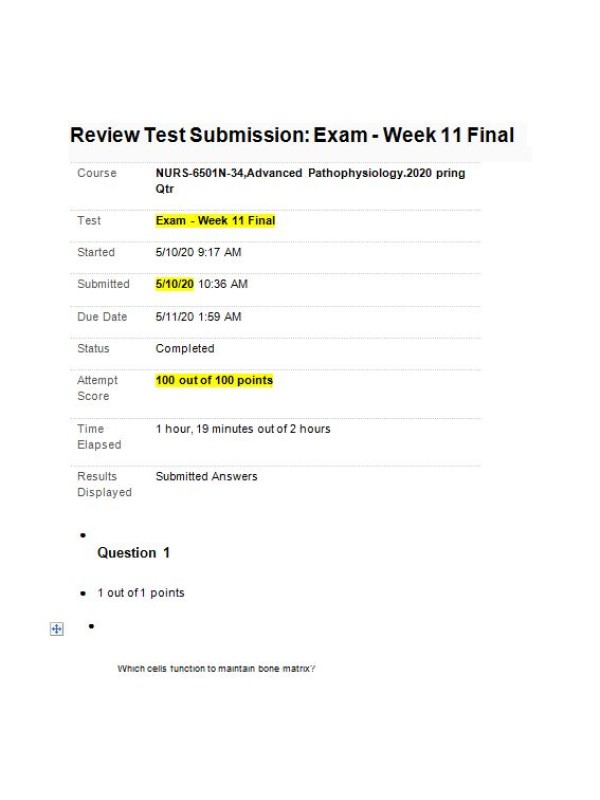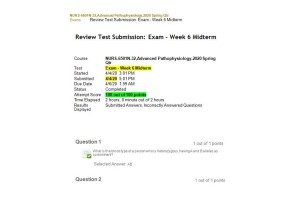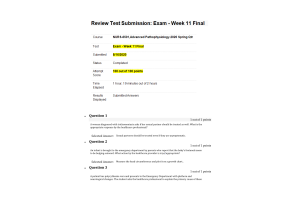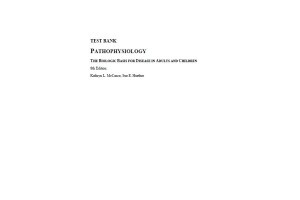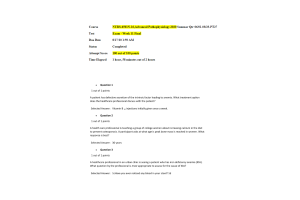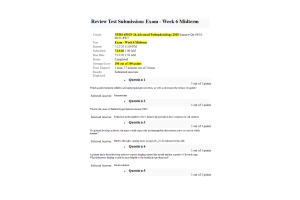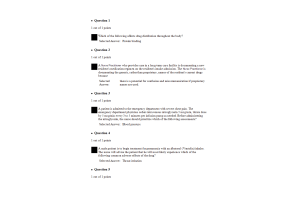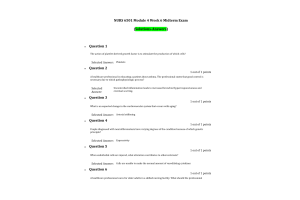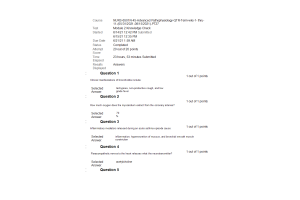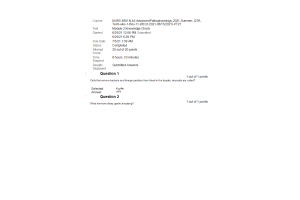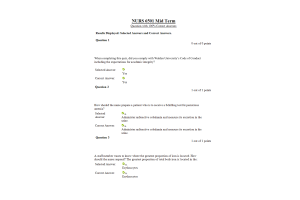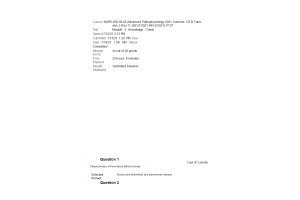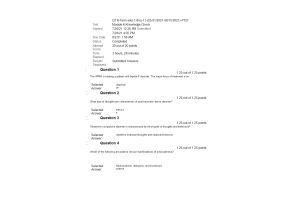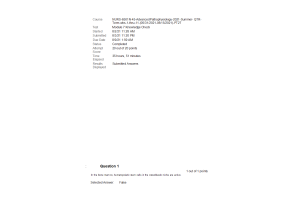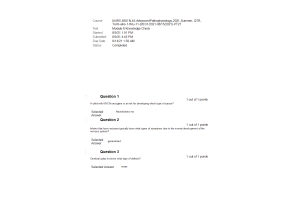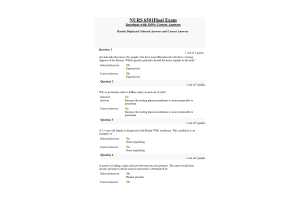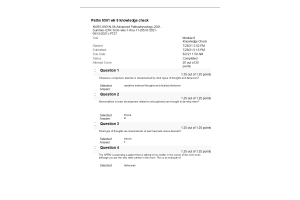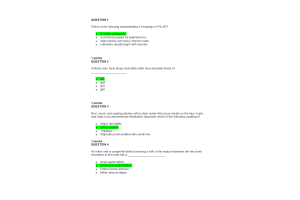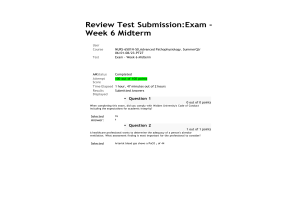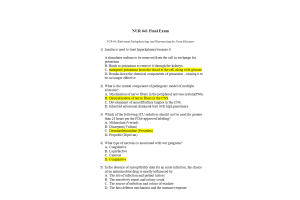NURS 6501 Week 11 Final Exam100 out of 100 Points
- $49.00
- Question: Which cells function to maintain bone matrix?
- Question: Prenatal exposure to diethylstilbestrol (DES) can result in which type of cancer?
- Question: Which statement by the professor best describes acute respiratory distress syndrome (ARDS)?
- Question: In infectious mononucleosis (IM), what does the Monospot test detect?
- Question: A patient has been hospitalized for a large deep vein thrombosis and states he is the third person in his family to have this condition in the last 2 years. What response by the healthcare professional is most appropriate?
- Question: The healthcare professor states that a patient has reached pain tolerance. What further information from the professor is most accurate?
- Question: A healthcare professional is teaching a community group about inherited disorders. What pattern of inheritance does the professional describe for sickle cell disease?
- Question: What is the link between major depression and cortisol secretion?
- Question: A healthcare professional is planning a community event to reduce risk of cerebrovascular accident (CVA) in high risk groups. Which group would the professional target as the priority?
- Question: A woman has been diagnosed with polycystic ovary syndrome but is confused because her pelvic ultrasound (US) was read as normal and did not show cysts. What response by the health care professional is most appropriate?
- Question: A child has iron deficiency anemia. In addition to iron supplements, what else does the healthcare professional educate the parents on giving the child?
- Question: A person has been diagnosed with acute lymphocytic leukemia (ALL) that is positive for the Philadelphia chromosome. What statement by the healthcare professional is most appropriate?
- Question: Cystic fibrosis is characterized by which symptom?
- Question: A patient has primary immune thrombocytopenic purpura (ITP) and is hospitalized after a bleeding episode. What treatment does the healthcare provider anticipate being ordered for this patient?
- Question: A hospitalized patient's lab work is as follows: WBC 2000, bands 14.8%, and segmented neutrophils 5. The healthcare professional calculates the patient's absolute neutrophil count (ANC). What action does the professional take next?
- Question: A patient has been diagnosed with acute lymphocytic leukemia (ALL) and asks the healthcare professional to describe it. What description by the professional is most accurate?
- Question: A healthcare professional is discussing breast feeding with a pregnant woman. Which beneficial substance does the professional tell the mother is found in breast milk?
- Question: Clinical manifestations that include irregular or heavy bleeding, the passage of large clots, and the depletion of iron stores support which diagnosis?
- Question: What is the consequence of a splenectomy?
- Question: What congenital malformation is commonly linked to acute leukemia in children?
- Question: The student wants to know how the clinical manifestations and onset of juvenile idiopathic arthritis (JIA) differ from those of rheumatoid arthritis (RA) in adults. What answer by the healthcare professional is best?
- Question: A student is learning about pelvic inflammatory disease (PID). What information does the student clarify with a study partner as being correct?
- Question: A newborn baby displays jaundice 20 hours after birth. What action by the healthcare professional is most appropriate?
- Question: A patient reports joint stiffness with movement and joint pain in weightbearing joints that is usually relieved by rest. What treatment option does the health care professional discuss with the patient?
- Question: How does the epididymis become infected?
- Question: An infant has a continuous machine-type murmur best heard at the left upper sternal border throughout systole and diastole. The healthcare professional suspects a congenital heart disorder. What other assessment finding is inconsistent with the professional's knowledge about this disorder?
- Question: A patient has damage to the lower pons and medulla. What finding does the healthcare professional associate with this injury?
- Question: A baby is born with a myelomeningocele and needs urgent surgery to repair the defect. The parents want to take the baby home instead. What does the healthcare professional tell the parents about the purpose of this surgery?
- Question: A healthcare professional is caring for a patient diagnosed with aphasia. What action by the professional would be best in working with this patient?
- Question: In which stage of syphilis would the following clinical manifestations be found: destructive skin, bone and soft tissue lesions, aneurysms, heart failure, and neurosyphilis?
- Question: A patient is 8 hours postoperative after a long orthopedic procedure. The student asks why this patient is at particular risk of developing a thromboembolism. What response by the healthcare professional is best?
- Question: The disruption in cellular adhesion observed in bullous impetigo is caused by an exfoliative toxin related to which organism?
- Question: A healthcare professional is reviewing a patient's laboratory results and sees that the patient has a low reticulocyte count and a high iron level. Which type of anemia does the professional associate these findings with?
- Question: A healthcare professional is caring for a patient who was rewarmed after suffering from hypothermia. What possible long-term complication will the professional continue to assess the patient for?
- Question: A professor explains to a class that the reason lymph nodes enlarge and become tender during infection is because of what reason?
- Question: Local signs and symptoms of Hodgkin disease-related lymphadenopathy are a result of what?
- Question: In immunoglobulin G (IgG) nephropathies such as glomerulonephritis, IgG is deposited in which location?
- Question: A man has balanitis. What action by the healthcare professional is most appropriate?
- Question: A person has a vascular anomaly associated with a congenital malformation of dermal capillaries and has been told this lesion does not fade with age. What treatment options can the healthcare professional discuss with this person?
- Question: A person comes to the healthcare clinic and reports night sweats and fever. The healthcare professional obtains a chest x-ray which shows a mediastinal mass. What other assessment or diagnostic test does the professional provide as a priority?
- Question: A patient had a seizure that consisted of impaired consciousness and the appearance of a dreamlike state. How does the healthcare professional chart this episode?
- Question: A healthcare professional had taught a pregnant woman about the risk of transmitting herpes simplex virus (HSV) from her to her fetus. What statement by the woman indicates the professional needs to provide more information?
- Question: An adult patient has been hospitalized with thrombocytopenia with a platelet count of 8000/mm 3. What action by the healthcare professional is most appropriate?
- Question: A healthcare professional works with recent refugees. A mother brings in her children who have been diagnosed with iron deficiency anemia. What action by the professional is most appropriate?
- Question: A patient has been diagnosed with lithium toxicity. Which electrolyte imbalance does the healthcare professional correlate with this condition?
- Question: A man reports to the healthcare professional that he had a sudden onset of malaise, low back pain, and perineal pain with high fever and chills, dysuria, nocturia, and urinary retention. What action by the healthcare professional is most appropriate?
- Question: A health care professional is caring for a patient admitted to the hospital with severe anorexia. What action by the health care professional would be most important?
- Question: A patient in the hospital has been receiving heparin injections. The platelet count on admission was 222,000/mm 3 and four days later is 113,000/mm 3. What action by the healthcare professional is best?
- Question: A child has phenylketonuria (PKU). The healthcare professional educates the parents on the special diet needed, telling them that children with PKU are unable to synthesize what?
- Question: Compared with an adult, an infant has a greater content of extracellular fluid, as well as a greater rate of fluid exchange. What effect does this have on the fluid balance of a child compared with that of an adult?
- Question: A parent brings a 10-year-old child to the clinic and reports a mottled appearance to the skin and legs cramps when the child is in physical education class. Physical assessment positive for upper extremity hypertension. What diagnostic testing or treatment does the healthcare professional prepare the family for?
- Question: A student asks the professor to explain the jaundice that accompanies hemolytic anemia. Which statement is by the professor is most accurate?
- Question: A patient in the healthcare clinic reports fatigue, weakness, and dyspnea, as well as pale conjunctiva of the eyes and brittle, concave nails. What assessment by the healthcare professional is most appropriate for the suspected anemia?
- Question: Which condition is considered a clinical cause of amenorrhea?
- Question: A child with acute poststreptococcal glomerulonephritis is voiding smoky, brown-colored urine and asks the healthcare professional to explain what causes it. What explanation by the professional is best?
- Question: A criterion for a diagnosis of generalized anxiety disorder (GAD) is a period of excessive worrying that lasts for at least how many months?
- Question: Which pain theory proposes that a balance of impulses conducted from the spinal cord to the higher centers in the central nervous system (CNS) modulates the transmission of pain?
- Question: A child has osteosarcoma and the healthcare team is assessing for metastases. What diagnostic study would be the priority?
- Question: A patient has been exposed to prolonged high environmental temperatures and now shows signs of dehydration, decreased plasma volumes, hypotension, decreased cardiac output, and tachycardia. What treatment does the healthcare professional prepare to administer to this patient?
- Question: A healthcare professional advises a pregnant woman to add supplements of which nutrient to her diet to prevent birth defects?
- Question: A parent asks the healthcare professional to explain why a child diagnosed with Tetralogy of Fallot squats frequently. What explanation by the professional is best?
- Question: What are the clinical manifestations of testicular cancer?
- Question: A woman attempting to conceive tells the healthcare professional that she and her partner have intercourse when her basal body temperature (BBT) is around 37˚C (98˚F) without getting pregnant. What information does the professional give the woman?
- Question: A healthcare professional is seeing a patient with suspected schizophrenia. For which prenatal occurrence should the professional assess?
- Question: What directly causes ovulation during the menstrual cycle?
- Question: A healthcare professional is educating a community men's group on symptoms of benign prostatic hyperplasia (BPH). The professional relates that most symptoms are a result of which pathophysiologic condition?
- Question: A woman who is positive for hepatitis B is in labor. What action by the healthcare professional is most appropriate?
- Question: An infant has been diagnosed with intussusception and the student asks the healthcare professional to explain the condition. What explanation by the professional is most accurate?
- Question: A patient has been hospitalized with Guillain-Barré syndrome (GBS). The patient asks how this could have occurred. What response by the healthcare professional is best?
- Question: A healthcare professional wants to volunteer for a community education project to help prevent spinal cord injury. What activity would the professional most likely volunteer for?
- Question: A child has Duchenne muscular dystrophy. What complication does the healthcare professional teach the parents is most important to control?
- Question: Which patient finding would lead the health care professional to assess the patient for inflammatory joint disease?
- Question: A student asks the health care professional why obese people are at higher risk for hypertension than non-obese individuals. What response by the professional is best?
- Question: A person has been diagnosed with primary dysmenorrhea and wants to know why ibuprofen is a good choice for pain control. What response by the health care professional is best?
- Question: A healthcare professional suspects a patient is brain dead. How would the professional assess for brain death?
- Question: A patient is in status epilepticus. In addition to giving medication to stop the seizures, what would the healthcare professional place highest priority on?
- Question: A newborn has meconium ileus. What diagnostic test does the healthcare professional advise the parents about?
- Question: Which statement is likely true regarding children being treated for cancer with radiation therapy?
- Question: A student studying osteomyelitis and asks for an explanation of the term sequestrum. What response by the professor is best?
- Question: To quickly assess a patient's nervous system for dysfunction, what assessment should the healthcare professional perform as the priority?
- Question: What is the most abundant class of plasma protein?
- Question: In acute hypothermia, what physiologic change shunts blood away from the colder skin to the body core in an effort to decrease heat loss?
- Question: A health care professional is teaching a group of college women about increasing calcium in the diet to prevent osteoporosis. A participant asks at what age is peak bone mass is reached in women. What response is best?
- Question: Which statement by the healthcare professional accurately describes childhood asthma?
- Question: A patient is in the intensive care unit and has intercranial pressure (ICP) monitoring. The patient's ICP is 17 mmHg. The healthcare professional notes that the chart indicates the patient is now in stage 1 intracranial hypertension. What assessment finding does the professional associate with this condition?
- Question: A healthcare professional is trying to lower a patient's body temperature by convection. What action by the professional will accomplish this?
- Question: How is gonorrhea transmitted from a pregnant woman to her fetus?
- Question: How should the healthcare professional reply when parents question why a computed tomographic (CT) scan of the head was not ordered for their 5-year-old child after a minor fall?
- Question: A patient has ankylosing spondylitis. Which description of this condition by the health care professional is most accurate?
- Question: A healthcare professional is caring for a patient who has a spinal cord injury at T5. The patient exhibits severe hypertension, a heart rate of 32 beats/min, and sweating above the spinal cord lesion. How does the professional chart this event?
- Question: What is the effect of low plasma albumin?
- Question: What initiates inflammation in acute poststreptococcal glomerulonephritis?
- Question: What diagnosis is given to parents when their infant's hip maintains contact with the acetabulum but is not well seated within the hip joint?
- Question: A person has abnormally severe tooth decay and erosion of the tooth enamel. What problem should the health care professional assess the person for?
- Question: A patient is admitted to the hospital with multiple myeloma (MM). Which diagnostic test should the healthcare professional assess as the priority?
- Question: In the majority of children experiencing delayed puberty, what is the problem caused by?
- Question: What does the student learn distinguishes kwashiorkor from marasmus?
- Question: Without prior exposure to an antigen, which cells are able to destroy some types of tumor cells and some virus-infected cells?
- Question: A patient has chronic anemia associated with chronic renal failure. What substance does the healthcare professional tell the patient is needed to treat this anemia?
- Question: A patient has pernicious anemia and asks the healthcare professional to explain the disease. Which statement by the professional is most accurate?
- Question: When completing this exam, did you comply with Walden University's Code of Conduct including the expectations for academic integrity?
